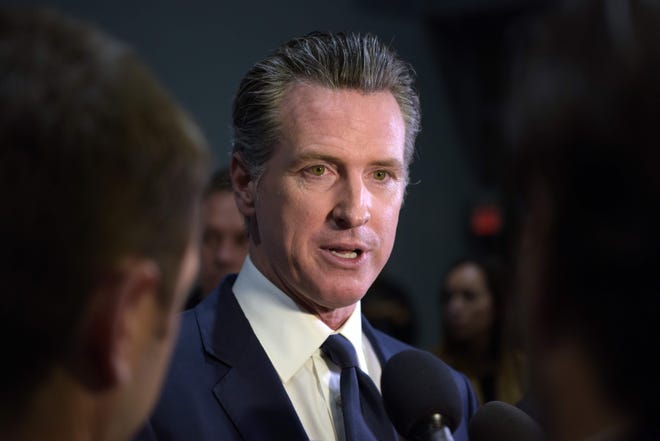Trump Reopens Shutdown Will It Be Shut Down Again
President Donald Trump makes no secret of his desire to reopen the country, even as coronavirus-related deaths mount and a vaccine may be more than a year away.
The president's push for an end to social distancing, once pegged to Easter Sunday when he envisioned churches brimming with worshippers, has put him at odds with his own top health advisers.
Sunday, Anthony Fauci, director of the National Institute of Allergy and Infectious Diseases, cautioned that any lessening of virus-related restrictions "is not going to be a light switch."
As that time approaches, a debate is churning over how America will emerge from a collective shutdown and who will throw the switch.
Monday, Trump claimed unilateral authority, almost certainly setting up clashes pitting the commander in chief against chief executives in states across the country where a crazy quilt of orders has dictated the terms of the national shutdown.
"It is the decision of the president," Trump tweeted.
Clashing with governors:Trump calls some governors 'complainers' as he's criticized over delivery of coronavirus supplies
Is it the president's decision?
Not exactly.
Federal law allows Washington to impose quarantines in some circumstances and limit travel between states, but the Trump administration has not invoked those powers. The Supreme Court has struck down attempts by the federal government to intervene within states. For instance, the court noted in a decision in 1985 that invalidated Food and Drug Administration rules for blood plasma donation centers that "the regulation of health and safety matters is primarily and historically a matter of local concern."
Trump wants to scale back restrictions:Is it all up to him?
"First and foremost, states currently retain power to decide who stays home and for how long," according to an analysis for Lawfare, a blog on national security issues. "Among the powers generally reserved to the states is the authority to quarantine individuals and otherwise protect public health." Those state decisions have sometimes drawn fire from federal officials.
Kentucky Gov. Andy Beshear announced Friday that parishioners attending Easter services would face a mandatory quarantine. Sen. Rand Paul and Rep.Thomas Massie, both Kentucky Republicans, slammed the governor's announcement as an overreach.
Attorney General William Barr suggested in an interview last week on Fox News that such restrictions were "draconian" and that the Justice Department would monitor the restriction closely to balance public health needs and religious liberty.
When did governors start enacting stay-at-home orders?
California was the first state to impose a stay-at-home order on March 19, a decision that was followed quickly by other governors imposing varying restrictions.
Arkansas is among the few places with no such order. "If we need to do more, we will do more," Gov. Asa Hutchinson told CNN Sunday.
Without a federal directive, what exists in much of the country is a patchwork of restrictions largely aimed at limiting large gatherings and shuttering nonessential businesses.
Coronavirus in the USA :How all 50 states are responding to the pandemic

As a result, governors and mayors have played an outsized role in the coronavirus crisis for at least two reasons: States enjoy broad autonomy under the Constitution, and the Trump administration has left most of the decision-making to them.
"We're a country not based on nationalizing our business," the president said last month, defending a decision not to use the Defense Production Act to order companies to produce medical supplies.
US coronavirus map:Tracking the outbreak
When did Trump declare a national emergency?
The president issued the national emergency declaration March 13, days after the World Health Organization formally declared the coronavirus a pandemic and as his administration wrestled with scrutiny over its initial response to the outbreak.
The national emergency was separate from Trump's announcement of a "public health" emergency in late January.
That designation, technically made by Health and Human Services Secretary Alex Azar, made it easier for states to redirect staff responding to the virus. The announcement was made in tandem with a quarantine order for U.S. citizens returning from hard-hit areas of China.
Beating coronavirus:This is what China did. Experts say America couldn't handle it
What does the national emergency order do?
Trump declared the national emergency under the Stafford Act, the same 1988 law presidents use to declare disaster areas after storms and other natural disasters, freeing up billions of dollar in Federal Emergency Management Agency funds to confront the coronavirus.
"This pandemic has the potential to cause severe consequences for our country's national and economic security," the president said in announcing the decision.
Fact check:Can Trump use Stafford Act to order a national mandatory quarantine?
Trump also invoked the National Emergencies Act, which allows the Department of Health and Human Services to modify or waive regulations for Medicare, Medicaid and other programs.
Among other things, the changes make it easier to offer tele-health services, so patients don't have to come to a doctor's office in person for some consultations, waiving certain licensing requirements so doctors can provide care across state lines and waiving capacity limits for hospitals.
What is Stafford Act?Trump's emergency order provides funds, flexibility for states
When do the state shutdown orders expire?
Although shutdowns in some states, including Alabama and Kansas, are set to expire this month, others carry indefinite timelines. In Virginia, Gov. Ralph Northam directed the shutdown to remain in effect until June 10.
The timelines underscore the varying terms of the states' restrictions. Florida and Texas included religious services among essential operations, putting them in potential conflict with health officials who cautioned against such gatherings.
Signaling that a reopening would not come all at once, governors on both coasts formed separate working groups to consider appropriate times for lifting restrictions.
Fact check:What's true and what's false about coronavirus?
Source: https://www.usatoday.com/story/news/politics/2020/04/13/coronavirus-shutdown-do-trump-states-decide-when-us-re-opens/2983171001/